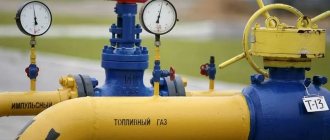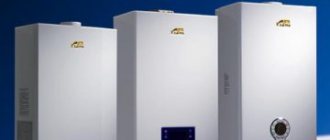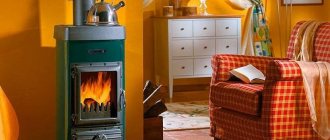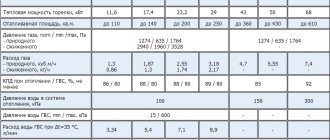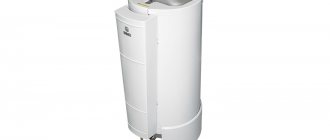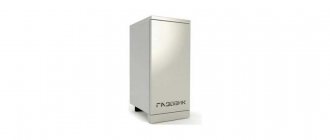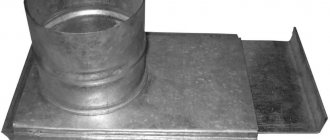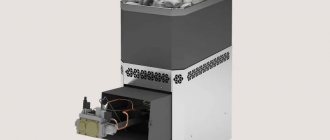The efficiency (coefficient of performance) of a heating boiler is the ratio of the volume of fuel consumed to the volume of heat generated. The efficiency of even the most efficient modern models of hot water boilers cannot be 100% due to heat loss inside the boiler, insufficient thermal conductivity of metals, or imperfections in the operating principle. In addition, the efficiency of the same gas boiler model also depends on the load: the efficiency indicated in the passport is not real in the entire range of heating output.
In the article we will look at how to correctly calculate efficiency, what it depends on and how to increase the efficiency of an already purchased boiler on your own.
Gross efficiency and net efficiency
Not all the heat generated during fuel combustion is used to heat the coolant; a certain part is spent on the boiler unit’s own needs: turbine, fan or smoke exhauster, circulation pump, operation of automation and electronic display, operation of the electric drive (as you already understand, all types of energy received are used in the calculation , including electricity, if the boiler is volatile).
Taking this into account, it is customary to divide the boiler efficiency by the generated heat ( gross efficiency ) and the released heat ( net efficiency ).
This classification allows us to highlight the degree of technical perfection of the boiler - gross efficiency or efficiency of fuel and electricity consumption - net efficiency.
Heat loss when removing flammable gases
The most significant heat losses occur as a result of the evacuation of flammable gases into the chimney (q2). The efficiency of the boiler largely depends on the combustion temperature of the fuel. The optimal temperature pressure at the cold end of the water heater is achieved when heated to 70-110 ℃.
When the temperature of the exhaust combustible gases drops by 12-15 ℃, the efficiency of the water heating boiler increases by 1%. However, in order to reduce the temperature of the exhaust combustion products, it is necessary to increase the size of the heated surfaces, and, therefore, the entire structure as a whole. In addition, as carbon monoxide cools, the risk of low-temperature corrosion increases.
Among other things, the temperature of carbon monoxide also depends on the quality and type of fuel, as well as the heating of the air entering the firebox. The temperatures of incoming air and exiting combustion products depend on the type of fuel.
To calculate the heat loss rate with flue gases, use the following formula:
Q2= (T1-T3) × (A2 ÷ (21-O2) + B), where
T1 – temperature of evacuated flammable gases at a point downstream of the superheater;
T3 – temperature of air entering the furnace;
21 – oxygen concentration in the air;
O2 is the amount of oxygen in the exhaust combustion products at the control point;
A2 and B are coefficients from a special table that depend on the type of fuel.
How to calculate the efficiency of a heating boiler
Values can be calculated in several ways. In European countries, it is customary to calculate the efficiency of a heating boiler based on the temperature of the exhaust gases (direct balance method), that is, knowing the difference between the ambient temperature and the actual temperature of the gases exiting through the chimney. The formula is quite simple:
ηbr = (Q1/Qir) 100% , where
- ηbr (read “this”) – boiler efficiency “gross”;
- Q1 (MJ/kg) – the amount of heat that was accumulated, i.e. used for heating the house.
- Qir (MJ/kg) – the total amount of heat released during fuel combustion;
For example, if Q1 = 19 MJ/kg, Qir = 22 MJ/kg, then gross efficiency = (19/22)*100 = 86.3%. All measurements are carried out at an already established, standard boiler operating mode.
The direct balance method does not take into account the heat loss of the boiler itself, underburning of fuel, deviations in operation and other features, so a fundamentally different, more accurate calculation method was invented - the “reverse balance method”. The equation used is:
ηbr = 100 – (q2 + q3 + q4 + q5 + q6) , where
- q2 – heat loss with exhaust gases;
- q3 – heat loss due to chemical underburning of combustible gases (applicable to gas boilers);
- q4 – loss of thermal energy with mechanical underburning;
- q5 – heat loss from external cooling (through the heat exchanger and housing);
- q6 – heat loss with physical heat of slag removed from the furnace.
Net efficiency of the heating boiler according to the reverse balance method:
ηnet = ηbr - Qs.n , where
- Qс.н – total consumption of thermal and electrical energy for own needs in % expression.
The actual efficiency will almost always differ from that declared by the manufacturer, since it depends on the correct installation of the boiler and heating system, smoke removal system, quality of power supply, etc. It is measured, accordingly, already on the spot.
How to increase the efficiency of heating equipment running on solid fuels
Today, many consumers, having at their disposal a solid fuel boiler, are trying to find the most convenient and practical way to increase the efficiency of heating equipment. The technological parameters of heating devices set by the manufacturer lose their nominal values over time, so various methods and means are being sought to increase the efficiency of boiler equipment.
Let's consider one of the most effective options, installing an additional heat exchanger. The task of the new equipment is to remove thermal energy from volatile combustion products.
In the video you can see how to make your own economizer (heat exchanger)
To do this, we first need to know what the temperature of the smoke at the outlet is. You can change it using a multimeter, which is placed directly in the middle of the chimney. Data on how much additional heat can be obtained from evaporating combustion products is necessary to calculate the area of the additional heat exchanger. We do the following:
- we send a certain amount of firewood into the firebox;
- We measure how long it takes for a certain amount of firewood to burn.
For example: firewood, in the amount of 14.2 kg. burn for 3.5 hours. The smoke temperature at the boiler outlet is 460 0 C.
In 1 hour we burned: 14.2/3.5 = 4.05 kg. firewood
To calculate the amount of smoke, we use the generally accepted value of 1 kg. firewood = 5.7 kg. flue gases. Next, we multiply the amount of wood burned in one hour by the amount of smoke produced by burning 1 kg. firewood As a result: 4.05 x 5.7 = 23.08 kg. volatile combustion products. This figure will become the starting point for subsequent calculations of the amount of thermal energy that can be additionally used to heat the second heat exchanger.
Knowing the value of the heat capacity of volatile hot gases as 1.1 kJ/kg, we make a further calculation of the heat flow power if we want to reduce the smoke temperature from 460 0 C to 160 degrees.
Q = 23.08 x 1.1 (460-160) = 8124 kJ thermal energy.
As a result, we obtain the exact value of the additional power provided by volatile combustion products: q = 8124/3600 = 2.25 kW, a large figure that can have a significant impact on increasing the efficiency of heating equipment. Knowing how much energy is wasted, the desire to equip the boiler with an additional heat exchanger is completely justified. Due to the influx of additional thermal energy for heating the coolant, not only the efficiency of the entire heating system increases, but also the efficiency of the heating unit itself increases.
What determines the thermal efficiency of boiler units?
The operating principle of a classic floor-mounted gas atmosphere.
The efficiency of heating boilers is not equal at any power; there is a proportional dependence on the load: an increase in the thermal load (the amount of fuel burned) also increases heat loss through the body or chimney. Likewise, operation at minimum power does not always ensure complete combustion of fuel, which leads to a decrease in efficiency.
For example, the service instructions for gas boilers Protherm Wolf KSO with a power of 12.5 kW and 16.0 kW indicate that when operating at maximum power (12.8 kW and 16.3 kW, respectively), the efficiency is 92.5%, while time when operating with a minimum load (4.5 kW and 5.8 kW) - will decrease and amount to only 78.4%.
This is one of the main reasons why you should take a conscious approach to choosing the power of the boiler unit. The most optimal operation in most models is achieved at a load in the range of 60-90% of maximum power.
Otherwise, the efficiency depends solely on the technological excellence of the model, aimed at reducing the above-described q2-6 (reducing the temperature of exhaust gases, efficient combustion of fuel, modulating burners, thermal insulation, etc.), as well as on the quality of maintenance and operation of the boiler unit. Cleanliness of the coolant, regular cleaning and flushing - all this over time seriously affects the efficiency.
How to choose a room thermostat and save up to 30% per month on heating
Operating rules for boiler devices, compliance with which affects the efficiency value
Any type of heating unit has its own optimal load parameters, which should be as useful as possible from a technological and economic point of view. The operation process of solid fuel boilers is designed in such a way that most of the time the equipment operates in optimal mode. This operation can be ensured by following the rules of operation of heating equipment operating on solid fuel. In this case, you must adhere to and follow the following points:
- it is necessary to observe acceptable modes of blowing and exhaust operation;
- constant control over the intensity of combustion and completeness of fuel combustion;
- control the amount of entrainment and failure;
- assessment of the condition of surfaces heated during fuel combustion;
- regular boiler cleaning.
The listed points are the necessary minimum that must be adhered to during the operation of boiler equipment during the heating season. Compliance with simple and understandable rules will allow you to obtain the efficiency of an autonomous boiler stated in the characteristics.
We can say that every little thing, every element of the design of a heating device affects the value of the efficiency factor. A properly designed chimney and ventilation system ensure optimal air flow into the combustion chamber, which significantly affects the quality of combustion of the fuel product. Ventilation performance is assessed by the excess air coefficient. An excessive increase in the volume of incoming air leads to excessive fuel consumption. Heat leaves more intensely through the pipe along with combustion products. When the coefficient decreases, the operation of boilers deteriorates significantly, and there is a high probability of oxygen-limited zones appearing in the furnace. In this situation, soot begins to form and accumulate in large quantities in the firebox.
The intensity and quality of combustion in solid fuel boilers require constant monitoring. The combustion chamber must be loaded evenly, avoiding focal fires.
On a note:
coal or firewood is evenly distributed over the grates or grate. Combustion should occur over the entire surface of the layer. Evenly distributed fuel dries quickly and burns over the entire surface, ensuring complete burnout of the solid components of the fuel mass to volatile combustion products. If you have correctly placed fuel in the firebox, the flame when the boilers are operating will be bright yellow, straw-colored.
During combustion, it is important to prevent failure of the fuel resource, otherwise you will have to face significant mechanical losses (underburning) of fuel. If you do not control the position of the fuel in the firebox, large fragments of coal or firewood falling into the ash box can lead to unauthorized combustion of the remaining fuel mass products.
Soot and resin accumulated on the surface of the heat exchanger reduce the degree of heating of the heat exchanger. As a result of all of the above violations of operating conditions, the useful volume of thermal energy required for the normal operation of the heating system decreases. As a result, we can talk about a sharp decrease in the efficiency of heating boilers.
Values of modern boilers depending on the type of fuel
| Photo | Type of boiler depending on the fuel burned | Average efficiency, % |
| Gas | ||
| — Convection | 87-94 | |
| — Condensation | 104-116* | |
| Solid fuel | ||
| — Wood-burning | 75-87 | |
| — Coal | 80-88 | |
| — Pellet | 80-92 | |
| Liquid fuel | ||
| — On diesel fuel | 86-91 | |
| — On fuel oil | 85-88 | |
| Electric heating elements | 99-99,5 |
*From a physics point of view, efficiency cannot exceed 100%: it is impossible to obtain more thermal energy than is released when burning fuel. However, it all depends on how you count. There are two definitions:
- lower calorific value - the heat obtained during the combustion of fuel, when the combustion products are simply removed through the chimney;
- higher calorific value - heat, including the energy contained in water vapor - one of the products of combustion of flammable gases.
Gas condensing boilers additionally accumulate the thermal energy of condensate formed from gas combustion products and deposited on an additional heat exchanger. Thus, a significant part of the heat does not “fly out into the chimney”, and the temperature of the exhaust gases is almost equal to atmospheric.
Construction of a simple condensing single-circuit gas boiler.
According to current standards, both in Russia and in Europe, the efficiency of heating boilers is calculated based on the lowest specific calorific value, so taking into account the additional heat extracted from the condensate leads to values of more than 100%. When calculated based on the higher calorific value, the efficiency of condensing gas boilers is 96-98%, depending on the model and type of installation: wall-mounted boilers usually have higher efficiency than floor-standing boilers (this applies to all gas boilers).
Also from the table you can see that the average efficiency of solid fuel boilers also differs depending on the fuel used, this is due to the degree of fuel combustion, its heat transfer, combustion temperature and heat loss with physical heat of slag removed from the combustion chamber. Even the same solid fuel boiler can produce different efficiencies when operating on different types of fuel.
conclusions
Despite the abundance of models of modern heating equipment, solid fuel boilers continue to be one of the most effective and affordable types of heating equipment. Compared to electric boilers, which have an efficiency of up to 90%, solid fuel units have a high economic effect. The increase in efficiency on new models has allowed this type of boiler equipment to come closer to electric and gas boilers.
Modern solid fuel devices are capable of not only operating for a long time using affordable natural fuel resources, but also have high performance characteristics.
BOILER EFFICIENCY COEFFICIENT
(Boiler efficiency) - the ratio of the amount of heat transferred to the boiler water to convert it into steam when burning 1 kg
fuel, to the calorific value of the fuel, i.e. the amount of heat that is released during complete combustion of 1
kg
of fuel. The efficiency of boilers reaches values of the order of 0.60-0.85.
Samoilov K.I. Marine dictionary. - M.-L.: State Naval Publishing House of the NKVMF of the USSR, 1941
See what “BOILER EFFICIENCY COEFFICIENT” is in other dictionaries:
- boiler efficiency
— 3.9 boiler efficiency ηK: Ratio of heating output Q to heat consumption QB: Source ...
efficiency
— 3.1 efficiency factor: A value characterizing the perfection of the processes of transformation, transformation or transfer of energy, which is the ratio of useful energy to supplied energy. [GOST R 51387, Appendix A] Source... Dictionary of terms of normative and technical documentation
The ratio of useful work expended or energy received to all work expended or, respectively, energy consumed. For example, the efficiency of an electric motor is the ratio of mechanical. the power it gives out to the electricity supplied to it. power; K.... ...Technical railway dictionary
The request for "KPD" is redirected here; see also other meanings. Efficiency factor (efficiency) is a characteristic of the efficiency of a system (device, machine) in relation to the conversion or transmission of energy. Determined by the attitude useful... ... Wikipedia
efficiency h
— 3.7 efficiency factor h, %: The ratio of useful output power to input heat. Source... Dictionary-reference book of terms of normative and technical documentation
GOST R 54442-2011: Heating boilers. Part 3. Gas central heating boilers. A unit consisting of a boiler body and a burner with forced air supply. Requirements for thermal testing
— Terminology GOST R 54442 2011: Heating boilers. Part 3. Gas central heating boilers. A unit consisting of a boiler body and a burner with forced air supply. Requirements for thermal testing original document: 3.10... ... Dictionary of terms of normative and technical documentation
— “Felix Dzerzhinsky” Steam locomotive FD21 3125 Basic data ... Wikipedia
Felix Dzerzhinsky ... Wikipedia
GOST R 54440-2011: Heating boilers. Part 1. Heating boilers with forced air burners. Terminology, general requirements, testing and marking
— Terminology GOST R 54440 2011: Heating boilers. Part 1. Heating boilers with forced air burners. Terminology, general requirements, testing and marking original document: 3.11 aerodynamic resistance of gas... ... Dictionary-reference book of terms of normative and technical documentation
This article lacks links to sources of information. Information must be verifiable, otherwise it may be questioned and deleted. You can... Wikipedia
The efficiency of a boiler unit or the efficiency of a boiler unit is the ratio of the amount of heat used in the boiler unit to the amount of heat expended in the fuel. Part of the steam produced in the boiler unit is directly spent on its own needs, for example, on feed pumps, blower fans, smoke exhausters, and blowing heating surfaces. Taking these costs into account, the concept of net efficiency of the boiler unit
.
Heat used in the boiler unit to produce steam or hot water,
where in -
hourly fuel consumption, kg/h (m3/h);
D—
hourly productivity of the boiler unit, kg/hour;
q
k.a - the amount of heat transferred to water in the boiler unit to convert it into steam or to produce hot water and referred to 1 kg of steam or water, kJ/kg (kcal/kg);
ŋ k.a is the efficiency of the boiler unit.
For a boiler unit that produces saturated steam
where i
» — enthalpy of saturated steam;
i p.v — enthalpy of feed water;
q pr
— amount of heat removed from the boiler unit with blowdown water, kJ/kg (kcal/kg);
usually q pr
= (0.01-0.02)
i
", where
i
" is the heat content of water at temperature t n.
For a hot water boiler unit that produces hot water
where i
1 is the enthalpy of water entering the boiler;
i
2 is the enthalpy of water leaving the boiler.
If the amount of steam produced and its enthalpy are known, as well as the hourly fuel consumption and the heat of combustion of the fuel, then the efficiency of the boiler unit can be determined, %:
For modern boiler units, the value q
1, depending on the steam output of the boiler unit, the temperature of the flue gases, the type of fuel burned and the method of its combustion, can vary within very wide limits from 75 to 80% for boiler units of small capacity, in which solid fuel is burned in layered furnaces, and up to 91-95 % for large boiler units with flaring fuel combustion. The highest efficiencies are obtained for boiler units operating on liquid and gaseous fuels.
For boiler units of small capacity, heat loss ranges from 20 to 25%, and for large ones from 5 to 9%. The main heat losses are losses with flue gases q
2
Example.
Determine the efficiency of the boiler unit and estimate the heat losses of the boiler unit with a steam capacity Q = 10 tons/hour with steam parameters: pressure
P
= 1.4 MPa (14 kgf/cm2) and temperature t = 197.3°C.
Hourly fuel consumption is 1500 kg, feed water temperature is 100°C, fuel combustion heat Q рн = 20647 kJ/kg (4916 kcal/kg). The heat losses of the boiler unit are assessed using the average values given in the relevant sections. The value q p p
(the amount of heat removed from the boiler unit with blowdown water) is taken equal to 0.
According to the table and the specified steam parameters: pressure p
and temperature
t
we find its enthalpy ~ 2790 kJ/kg (666 kcal/kg).
At 100°C the heat content of the feed water will be approximately 419 kJ/kg (100 kcal/kg). Therefore, the heat received by 1 kg of steam according to the formula is q
to
. a = 2790 - 419 = 2371 kJ/kg ( qk
. a = 666 - 100 = 566 kcal/kg).
The efficiency of the boiler unit according to the formula
The amount of heat loss
Σ
q i =
100 - ŋ k.a = 100 - 76.8 = 23.2%.
Based on the average values of q
2 ,
q
3
, q
4 given in § Heat balance of the boiler unit, we find
q
2 = 12.5%,
q
3 = 1%,
q
4 = 6.25%.
Consequently, the amount of losses to the environment is q
5 = Σ
q i
-
q
2 -
q
3 -
q
4 = 23.2 - 12.5 - 1 - 6.25 = 3.45%. ,
Creating a cozy and comfortable atmosphere in a country house is quite simple - you just need to properly equip the heating system. The main component of an efficient and reliable heating system is the boiler. In the article below, we will talk about how to calculate the efficiency of a boiler, what factors influence it, and how to increase the efficiency of heating equipment in a particular home.
How to increase the efficiency of a gas boiler
It is almost impossible to increase the efficiency of fuel combustion by interfering with the technical structure of the boiler; it will not be possible to install the same layer of thermal insulation due to the banal failure of the manufacturer to provide a place for it. In addition, doing this yourself is prohibited. Nevertheless, there are ways to increase the efficiency of a gas boiler, especially if it is an imperfect old-style model:
- Ready-made economizer for chimney – replaces a certain section of the chimney and is designed to accumulate heat from gases exhausted through the chimney (some kind of imitation of condensing boilers). However, it is necessary to accurately calculate the parameters of the economizer and the requirements for the chimney in order to maintain the necessary draft and prevent reverse draft, for example, in strong winds. The issue price is 1,700-2,500 rubles.
Sandwich mesh economizer for chimney pipe. - A homemade economizer is almost identical to the finished products described above. We have already described how to make an effective economizer in one of the previous articles.
- Cleaning the boiler and flushing the heat exchanger are regular maintenance measures that are meaningless for new boiler units, but extremely effective for those that have been in use for at least several seasons. The fact is that during operation, scale and other salt deposits form inside the heat exchanger, and the external fins of the heat exchanger, burners and igniter become clogged. All this leads to an increase in gas consumption, a decrease in heating output, and, accordingly, a decrease in efficiency (often up to 20-30%). We have also already discussed how and how often it is necessary to clean a gas boiler.
- Gas filter - it is installed in front of the shut-off valve of the gas main and is designed to clean the gas from debris and impurities that are sometimes found in the composition. This not only helps reduce soot formation, but also, by improving the quality of the fuel, slightly reduces heat loss during underburning.
The remaining methods involve proper commissioning, which is carried out once, when the boiler is first started, exclusively by specialists. With correct initial settings, the efficiency guaranteed by the manufacturer is ensured. It is important to understand that it is impossible to increase this indicator by interfering with the technical structure of the boiler itself, and even more so, it is not safe.
Instructions BoilersEnergy-saving technologies
Installing radiators for maximum efficiency
Radiators are installed in areas where heat loss in the room is most significant, for example, next to windows. To achieve maximum efficiency, the window sill should cover about 2/3 of the upper plane of the battery and be approximately 10 cm from its surface. The recommended distance between the radiator and the floor is 12 cm. The rear surface of the battery should be separated from the wall by 2 cm. This will create proper natural convection , in which a certain amount of heat is spent on heating the wall and blocking heat loss in the room, and most of the energy is directed to heating.
Safety measures for increasing efficiency
Just 20-30 years ago, the price of energy resources in the post-Soviet space was low, so no one paid attention to such a parameter as efficiency. After all, performance could decide everything. But when gas began to rise in price, and modern technologies were still unavailable, craftsmen began to modernize gas boilers in order to increase efficiency, using accessible methods.
When performing any work with gas equipment, it is necessary to observe safety measures and possess special skills and tools. And also you should not use methods prohibited by law to increase efficiency.
For example, attaching copper and aluminum plates to heat exchangers to improve heat transfer. Heat loss from structural elements of heating devices was reduced by welding third-party elements. The automation and heat exchangers were changed. Other similar methods were also used. Efficiency increased, but the state and the gas service did not react to the “creativity” of the craftsmen.
Now everything is different and relevant laws prohibit changing the design of gas boilers, which must be certified, like all their individual elements. As a result, it is impossible to increase efficiency by replacing mechanical, electrical and other components of heating devices with third-party ones.
Violation of these requirements may result in:
- Administrative responsibility. If Gorgaz employees detect tampering with the boiler design, but there were no incidents, they will have to pay a fine of 10-15 thousand rubles. This is indicated by Article 7.19 of the Administrative Code. In severe cases, the gas service has the right to even terminate the service contract and stop supplying fuel.
- Criminal liability. As evidenced by Federal Law No. 229-FZ of July 29, 2018 “On amendments to Article 215.3 of the Criminal Code of the Russian Federation and Articles 150 and 151 of the Code of Criminal Procedure of the Russian Federation.” These standards will come into force if design changes lead to serious consequences.
That is, it’s not worth risking people’s lives to increase the efficiency of the boiler by a few percent.
Chemical underburning as a source of heat loss
The q3 indicator is used when calculating the efficiency of a gas heating boiler, for example, or in cases where fuel oil is used as fuel. For gas boilers, the q3 value is 0.1-0.2%. With a slight excess of air during combustion, this figure is 0.15%, and with a significant excess of air it is not taken into account at all. However, when burning a mixture of gases of different temperatures, the value of q3 = 0.4-0.5%.
If the heating equipment runs on solid fuel, the q4 indicator is taken into account. In particular, for anthracite coal the value of q4 = 4-6%, semi-anthracite is characterized by 3-4% heat loss, but when burning hard coal, only 1.5-2% heat loss is formed. For liquid slag removal of burned low-reaction coal, the value of q4 can be considered minimal. But when removing slag in solid form, heat loss will increase to the maximum limit.


